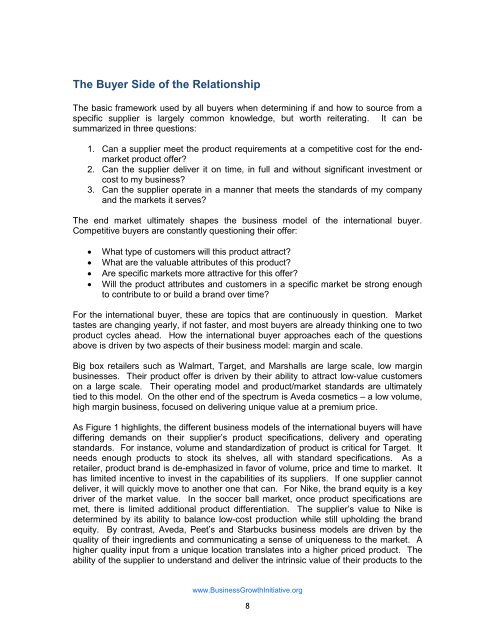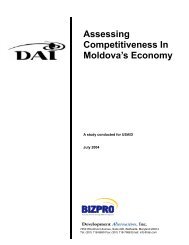the ties that bind - Economic Growth - usaid
the ties that bind - Economic Growth - usaid
the ties that bind - Economic Growth - usaid
Create successful ePaper yourself
Turn your PDF publications into a flip-book with our unique Google optimized e-Paper software.
The Buyer Side of <strong>the</strong> Relationship<br />
The basic framework used by all buyers when determining if and how to source from a<br />
specific supplier is largely common knowledge, but worth reiterating. It can be<br />
summarized in three questions:<br />
1. Can a supplier meet <strong>the</strong> product requirements at a competitive cost for <strong>the</strong> endmarket<br />
product offer?<br />
2. Can <strong>the</strong> supplier deliver it on time, in full and without significant investment or<br />
cost to my business?<br />
3. Can <strong>the</strong> supplier operate in a manner <strong>that</strong> meets <strong>the</strong> standards of my company<br />
and <strong>the</strong> markets it serves?<br />
The end market ultimately shapes <strong>the</strong> business model of <strong>the</strong> international buyer.<br />
Competitive buyers are constantly questioning <strong>the</strong>ir offer:<br />
What type of customers will this product attract?<br />
What are <strong>the</strong> valuable attributes of this product?<br />
Are specific markets more attractive for this offer?<br />
Will <strong>the</strong> product attributes and customers in a specific market be strong enough<br />
to contribute to or build a brand over time?<br />
For <strong>the</strong> international buyer, <strong>the</strong>se are topics <strong>that</strong> are continuously in question. Market<br />
tastes are changing yearly, if not faster, and most buyers are already thinking one to two<br />
product cycles ahead. How <strong>the</strong> international buyer approaches each of <strong>the</strong> questions<br />
above is driven by two aspects of <strong>the</strong>ir business model: margin and scale.<br />
Big box retailers such as Walmart, Target, and Marshalls are large scale, low margin<br />
businesses. Their product offer is driven by <strong>the</strong>ir ability to attract low-value customers<br />
on a large scale. Their operating model and product/market standards are ultimately<br />
tied to this model. On <strong>the</strong> o<strong>the</strong>r end of <strong>the</strong> spectrum is Aveda cosmetics – a low volume,<br />
high margin business, focused on delivering unique value at a premium price.<br />
As Figure 1 highlights, <strong>the</strong> different business models of <strong>the</strong> international buyers will have<br />
differing demands on <strong>the</strong>ir supplier‟s product specifications, delivery and operating<br />
standards. For instance, volume and standardization of product is critical for Target. It<br />
needs enough products to stock its shelves, all with standard specifications. As a<br />
retailer, product brand is de-emphasized in favor of volume, price and time to market. It<br />
has limited incentive to invest in <strong>the</strong> capabili<strong>ties</strong> of its suppliers. If one supplier cannot<br />
deliver, it will quickly move to ano<strong>the</strong>r one <strong>that</strong> can. For Nike, <strong>the</strong> brand equity is a key<br />
driver of <strong>the</strong> market value. In <strong>the</strong> soccer ball market, once product specifications are<br />
met, <strong>the</strong>re is limited additional product differentiation. The supplier‟s value to Nike is<br />
determined by its ability to balance low-cost production while still upholding <strong>the</strong> brand<br />
equity. By contrast, Aveda, Peet‟s and Starbucks business models are driven by <strong>the</strong><br />
quality of <strong>the</strong>ir ingredients and communicating a sense of uniqueness to <strong>the</strong> market. A<br />
higher quality input from a unique location translates into a higher priced product. The<br />
ability of <strong>the</strong> supplier to understand and deliver <strong>the</strong> intrinsic value of <strong>the</strong>ir products to <strong>the</strong><br />
www.Business<strong>Growth</strong>Initiative.org<br />
8

















